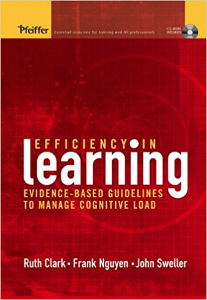Efficiency in Learning

This book explains in specific detail what we know about cognitive load and how to design learning programs to accommodate our cognitive limits. It includes videos from Sweller, the educational psychologist known for his work in this area.
My reading notes
Part 1: An introduction to efficiency in learning
Ch. 1: Cognitive load and efficiency in learning
Ch. 2: The psychology of efficiency
Part 2: Basic guidelines for managing (irrelevant) cognitive load
Ch. 3: Use visuals and audio narration to exploit working memory resources
Ch. 4: Focus attention and avoid split attention
Ch. 5: Weed your training to manage limited working memory capacity
Ch. 6: Provide external memory support to reduce working memory load
Ch. 7: Use segmenting, sequencing, and learner pacing to impose content gradually
Ch. 8: Transition from worked examples to practice to impose mental work gradually
Part 3: Instructional guidelines for imposing relevant cognitive load
Ch. 9: Put working memory to work with germane load
Part 4: Tailoring instruction to learner expertise
Ch. 10: Accommodate differences in learner expertise
Ch. 11: Use rapid testing to adapt e-learning to learner expertise
Part 5: Cognitive load theory in perspective
Ch. 12: Applying cognitive load theory
Ch. 13: The evolution of cognitive load theory: A personal perspective by John Sweller